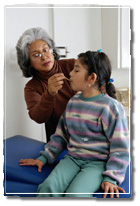 Your knowledge of your patients development and your continuing rapport with them are probably your most powerful tools in preventing and diagnosing substance use, abuse and dependence. Since alcohol and other drugs are not used in vacuo, your knowledge of individual children, how they are getting along with their families, their teachers, and their peers is invaluable.
Your knowledge of your patients development and your continuing rapport with them are probably your most powerful tools in preventing and diagnosing substance use, abuse and dependence. Since alcohol and other drugs are not used in vacuo, your knowledge of individual children, how they are getting along with their families, their teachers, and their peers is invaluable.
Be on the lookout for behavioral signals. Behavioral changes or problems that have developed since a childs last visit are often evident after even brief interviews with the patient and parent. Usually, children who are involved with alcohol and other drugs send out behavioral signals and frequently such changes or problems will emerge during the routine questioning you undertake as part of your examination.
Using Opportunities to Discuss Substance Abuse
The amount of time you can spend with any patient is very limited, but even that required for a routine physical examination can be used to explore possible substance use and encourage a drug-free lifestyle. The routine chest examination provides an excellent opportunity to ask about cigarette smoking and marijuana use. Since the youngster may believe that you can detect use of these substances by your chest auscultation, he or she will usually respond openly to direct, but nonjudgmental inquiry. Routinely asking about alcohol use in the childs school and among his or her peers readily leads to questions about personal use. This questioning is likely to be non-threatening to your patient in the context of your concern for his or her overall health and well being.
Patient Reactions to Your Questions
An important clue to more serious involvement with substance abuse is marked defensiveness about the essence of alcohol or other drug use or any kind of emotional response to your routine questions. If this reaction occurs, it provides a further basis for inquiry, indicating the patient that the topic seems to be a sensitive one and making the patient aware that you wonder why.
Why is the Patient Using Drugs?
The drug use may be the patients way of self-medicating anxiety or dealing with problems in living or a lack of self-esteem. But even though drugs may temporarily alleviate some of these feelings, substance abuse is destructive to emotional maturation and other aspects of growth and development. Thus, objective confirmation can sometimes be a relief to all concerned, making it easier for both the youngster and the parent(s) to acknowledge that a problem requiring their attention exists.
How to Respond to Isolated or Minimal Use

- The Alcohol Argument
-
Young people are sometimes very indignant that adult use of alcohol or tobacco is socially acceptable, but their drug use is not. Emphasizing that abuse of all drugs, including alcohol and tobacco, is a serious medical and social problem and that your concern is with the health and development hazards, regardless of the drugs legal status or social acceptability, may help to defuse the argument.
- The intoxication Issue
-
Making the point that intoxication with any substance is undesirable at any age and especially while undergoing marked developmental changes and acquiring the necessary skills for adult life, may also be useful. Since using marijuana is a form of intoxication more analogous to getting drunk, the argument that the adolescents “joint” is like the adults before dinner cocktail loses much of its force.
- The Health and Developmental Implications of Use
-
Frank acknowledgement of the seriousness of adult alcohol, tobacco, and other drug use can make it clear that you are not advocating a double standard. You should make clear to your patient that your concern is with the health and developmental implications of use. Moreover, just as there is good reason to be particularly concerned about diet and other health habits during pregnancy, there are equally good reasons for concern about behavior that can potentially interfere with healthy childhood or adolescent development.
